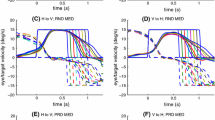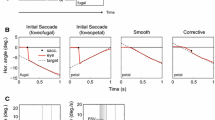Summary
Horizontal smooth pursuit eye movements were recorded in normal subjects in response to different patterns of target motion that was either periodic or not. Periodic patterns were triangular and sinusoidal waves. Non-periodic patterns were ramps with either constant or sinusoidally varying velocity. In both cases, several different amplitudes and peak velocities were considered. The experimental results indicate that (a) the performance of the smooth pursuit system depends on the spatio-temporal characteristics of target motion, (b) the relationship between smooth pursuit eye velocity and target velocity during the tracking of constant velocity ramps is strongly nonlinear with a saturation depending on the amplitude of target excursion, (c) in the remaining experimental conditions, there is a linear behaviour up to target velocities of 75 deg/s with a gain of about 0.9.
Similar content being viewed by others
References
Bahill AT, McDonald JD (1983a) Smooth pursuit eye movements in response to predictable target motions. Vision Res 23: 1573–1583
Bahill AT, McDonald JD (1983b) Model emulates human smooth pursuit system producing zero-latency target tracking. Biol Cybern 48: 213–222
Baloh RW, Kumley WE, Sills AW, Honrubia V, Konrad HR (1970) Quantitative measurement of smooth pursuit eye movements. Ann Otol Rhinol Laryngol 85: 111–119
Barmack NH (1970) Dynamic visual acuity as an index of eye movement control. Vision Res 10: 1377–1391
Becker W, Fuchs AF (1985) Prediction in the oculomotor system: smooth pursuit during transient disappearance of a visual target. Exp Brain Res 57: 562–575
Brown JF (1931) The visual perception of velocity. Psychologische Forschung 14: 199–232
Buizza A, Avanzini P (1983) Computer analysis of smooth pursuit eye movements. In: Groner R, Menz C, Fisher DF, Monty RA (eds) Eye movements and psychological functions. L Erlbaum Ass, Hillsdale NJ, pp 7–17
Buizza A, Schmid R (1983) Model interpretation of visual-vestibular interaction in patients with labyrinthine and cerebellar pathologies. Biol Cybern 47: 203–211
Buizza A, Schmid R, Droulez J (1981) Influence of linear acceleration on oculomotor control. In: Fuchs AF, Becker W (eds) Progress in oculomotor research. Elsevier/North-Holland, New York, pp 517–524
Buizza A, Schmid R, Gigi MR (1984) The range of linearity of the smooth pursuit control system. In: Gale AG, Johnson F (eds) Theoretical and applied aspects of eye movement research. Elsevier Science Publ BV (North-Holland), Amsterdam, pp 473–480
Büttner U, Waespe W (1984) Purkinje cell activity in the primate flocculus during optokinetic stimulation, smooth pursuit eye movements and VOR-suppression. Exp Brain Res 55: 97–104
Collewijn H, Tamminga EP (1984) Human smooth pursuit and saccadic eye movements during voluntary pursuit of different target motions on different backgrounds. J Physiol 351: 217–250
Dallos PJ, Jones RW (1963) Learning behavior of the eye fixation control system. IEEE Trans AC-8: 218–227
Henn V, Cohen B, Young LR (1980) Visual-vestibular interaction in motion perception and the generation of nystagmus. Neurosci Res Progr Bull 18(4). MIT Press, Cambridge, Massachusetts
Hutton Th, Nagel JA, Loeweson RB (1983) Variables affecting eye tracking performance. Electroencephalogr Clin Neurophysiol 56: 414–419
Lisberger SG, Evinger LC, Johanson GW (1977) Smooth pursuit tracking of periodic and non-periodic targets in man. Soc Neurosci Abstr 36: 156
Lisberger SG, Evinger LC, Johanson GW, Fuchs AF (1981) Relationship between eye acceleration and retinal image velocity during foveal smooth pursuit in man and monkey. J Neurophysiol 46: 229–249
Melvill Jones G, Gonshor A (1982) Oculomotor response to rapid head oscillation (0.5–5.0 Hz) after prolonged adaptation to vision reversal. Exp Brain Res 45: 45–58
Meyer CH, Lasker AG, Robinson DA (1985) The upper limit of human smooth pursuit velocity. Vision Res 25: 561–563
Rashbass C (1961) The relationship between saccadic and smooth tracking eye movements. J Physiol 159: 326–338
Robinson DA (1965) The mechanics of human smooth pursuit eye movements. J Physiol 180: 569–591
Robinson DA (1971) Models of oculomotor neural organization. In: Bach-y-Rita P, Collins CC, Hyde JE (eds) The control of eye movements. Academic Press, New York, pp 519–538
Robinson DA (1981) Control of eye movements. In: Brooks VB (ed) Handbook of physiology, Sect I. The nervous system, Vol II, Part 2. American Physiological Society, Bethesda, Md, pp 1275–1320
Schmid R, Buizza A, Zambarbieri D (1980) A non-linear model for visual-vestibular interaction during body rotation in man. Biol Cybern 36: 143–151
Stark L, Vossius G, Young LR (1962) Predictive control of eye tracking movements. IRE Trans HFE-3: 52–57
Takahashi M, Uemura T, Fujishiro T (1983) Quantitative analysis of pursuit eye movements by unidirectional target motion. Arch Oto-Rhino-Laryngol 238: 225–232
Waespe W, Rudinger D, Wolfensberger M (1985) Purkinje cell activity in the flocculus of vestibular neuroectomized and normal monkeys during optokinetic nystagmus (OKN) and smooth pursuit eye movements. Exp Brain Res 60: 243–262
Westheimer G (1954) Eye movement responses to a horizontally moving visual stimulus. Arch Ophthalmol 52: 932–941
Wyatt HJ, Pola J (1983) Smooth pursuit eye movements under open-loop and closed-loop conditions. Vision Res 23: 1121–1131
Yasui S, Young LR (1984) On the predictive control of foveal eye tracking and slow phases of optokinetic and vestibular nystagmus. J Physiol 347: 17–33
Young LR (1971) Pursuit eye tracking movements. In: Bach-y-Rita P, Collins CC, Hyde JE (eds) The control of eye movements. Academic Press, New York, pp 429–443
Author information
Authors and Affiliations
Rights and permissions
About this article
Cite this article
Buizza, A., Schmid, R. Velocity characteristics of smooth pursuit eye movements to different patterns of target motion. Exp Brain Res 63, 395–401 (1986). https://doi.org/10.1007/BF00236858
Received:
Accepted:
Issue Date:
DOI: https://doi.org/10.1007/BF00236858




